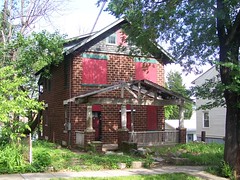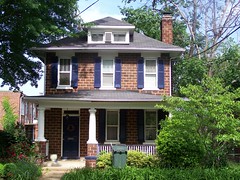Investment vs. Disinvestment

The boarded up odd brick four square on 7th Street NE, Brookland.
This house doesn't look as bad as it had been looking for years. The failure to take care of the property was very evident, with window frames decrepit or broken glass panes, and the ribs of the trusses for the porch sticking out like the ribs of someone malnourished, as the "skin" of the porch roof was no longer in evidence. At some point within the past few months, the building was boarded up.

This is the house next door, fully taken care and "kept up," demonstrating that the problem with the boarded up house isn't the house, it's the owner, who for whatever reason, has failed to take care of the property.
-----
I write from time to time about what I call "the language of revitalization." The real issue is disinvestment. What people call "blight" is a result of disinvestment. Rather than blame the place (I call this "blaming the building"), focus on disinvestment and explain the process.
Buildings or neighborhoods called dilapidated, run-down, blight, eyesores, nuisances, decrepit, (etc.) are victims (and survivors) of disinvestment.The solution is not demolition, but investment instead of disinvestment. And maintenance and/or rehabilitation is the proper response to neglect or demolition-by-neglect.
Too often people are lulled into believing that demolition, especially of historic buildings, is a solution to "blight" when merely it creates a different form of blight, one that is harder and usually more expensive to correct (building a new building).

Clearly this is a book that Mayor Fenty needs to read.
Labels: historic preservation, urban design/placemaking, urban history, urban renewal, urban revitalization



0 Comments:
Post a Comment
<< Home